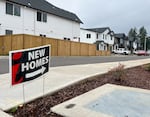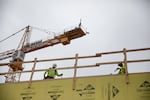
New construction in an unincorporated community in Clackamas County pictured in early 2025. Tariffs pushed a Coos Bay builder to switch materials, driving up home prices as Oregon struggles with a housing shortage.
Andrew Theen / OPB
Developer Greg Drobot and his team are hoping to sell the houses they’re building in Coos Bay for around $400,000.
“We are trying to build these homes as economically efficient as possible,” Drobot said.
Construction on the project started this year, and the first set of homes are expected to be complete in about a year.
Keeping costs down means paying attention to the price for every detail. Drobot said instead of plywood, the project was going to use a less-expensive engineered wood, called oriented strand board, that comes from Canada.
“When the tariffs hit, it made it almost cost-prohibitive for us to use that,” Drobot said. “So what it then made us pivot to was just old-fashioned domestic plywood, which is more expensive, but we don’t have another choice. In that specific example, a tariff directly caused us to pivot our supply chain to source a domestic input, which is going to increase the price of homes.”
The tariffs come as Oregon’s homelessness crisis is beyond emergency level. Many factors contribute to the catastrophe, but experts say the root cause is a statewide lack of available affordable housing. In Coos Bay, researchers say the city needs at least 600 new homes by 2040 to meet the area’s needs.
Related: Tariffs will do lasting damage to Oregon’s trade relationships, businesses tell governor
Gov. Tina Kotek set a goal of building 36,000 homes per year when she took office in 2023. The state has fallen short with builders taking out fewer than 15,000 residential construction permits last year, and short of 18,000 the year before.
The Trump administration’s increasing trade tensions in the form of tariffs are almost certain to put Oregon’s new home construction goal even further out of reach. Imported components for new houses and apartments like drywall, lumber, appliances and steel are going up in price, as are the tools and equipment needed to build new homes.
When asked about how tariffs will impact Oregon’s housing goals, Kotek said she’s concerned they’ll make it harder and more expensive to get materials like wood — even though Oregon produces some wood products.
“At the scale we need to build, we are importing,” she said.
Kotek said builders also import things like fixtures, electrical wiring and other equipment that already take a long time to get to construction sites.
“And now with the additional tariffs, [it’s] almost impossible to get some of them,” Kotek said. “So it will impact our ability to construct new homes.”

FILE - Two workers plan out next steps at a housing construction site in Portland, Ore., on July 7, 2023. Tariffs are raising material costs and delaying supplies, making it harder for Oregon to meet Gov. Tina Kotek’s housing construction goals.
Caden Perry / OPB
Developers say it’s already expensive and challenging to build in Oregon. Across the state, housing providers face rising insurance and utility costs, long wait times for permits and barriers to funding.
“Tariffs are icing on the cake,” Ben Murphy, director of multifamily investments at advisory firm Commercial Integrity NW, said.
Property developers are stocking up on imported appliances and other supplies, if they’re able to, Murphy said.
“I talked to a client who ordered 30 air conditioning units because of their fear of these costs skyrocketing,” he said. “And they will.”
Murphy said tariffs on Mexico and Canada in particular are already raising prices — and the anxiety over potential new tariffs is stalling new investments.
“Every day there’s a new headline and a lot of people don’t know what the Trump administration is going to do,” he said. “When you can’t pinpoint what they’re going to do, and there’s all this fear and uncertainty and volatility, it’s hard to budget — and it’s hard for a developer to come up with a cost estimate to build a new property.”
It’s a nationwide problem that homebuilders warned about before President Donald Trump levied his first round of tariffs.
In a January letter to Trump, National Association of Home Builders senior officer Carl Harris said builders already face rising costs — 30% for residential construction since July 2021 — and challenges getting materials.
“Our sector relies heavily on a diverse and cost-efficient supply chain for building materials such as lumber, steel, gypsum and aluminum,” Harris wrote. “While home building is inherently domestic, builders rely on components produced abroad, with Canada and Mexico representing nearly 25% of building materials imports.”
Related: Tariff threats could spook investment among Oregon companies
Harris said the tariffs will make materials more expensive, and that expense will likely be passed on to homebuyers in the form of higher housing prices.
That’s the concern of Drobot, the developer in Coos Bay. His project has about a 15% contingency on cost, so they are able to absorb some of the price increases — but not at the rate tariffs are threatening to push them up. If prices go up more than that, Drobot’s company will either have to pass on the cost to the homebuyer or find ways to cut costs.
“I’m sure there’ll be some very difficult decisions down the road,” he said.
However, Drobot continues to be bullish on the project. He’s been developing commercial properties in the south coast region for more than a decade. Business owners continually tell him they’d hire more staff and expand their companies if there were more places to live.
Still, he’s concerned economic uncertainty will hurt consumer sentiment. The first set of homes are expected to be done in spring 2026, and he wants them priced to sell — something that could be hard to do if tariffs force higher asking prices than consumers feel confident spending.
“Every dollar, every thousand dollars that I ask more,” Drobot said, “that’s just the potential for a buyer to say, ‘it’s too expensive.’”
